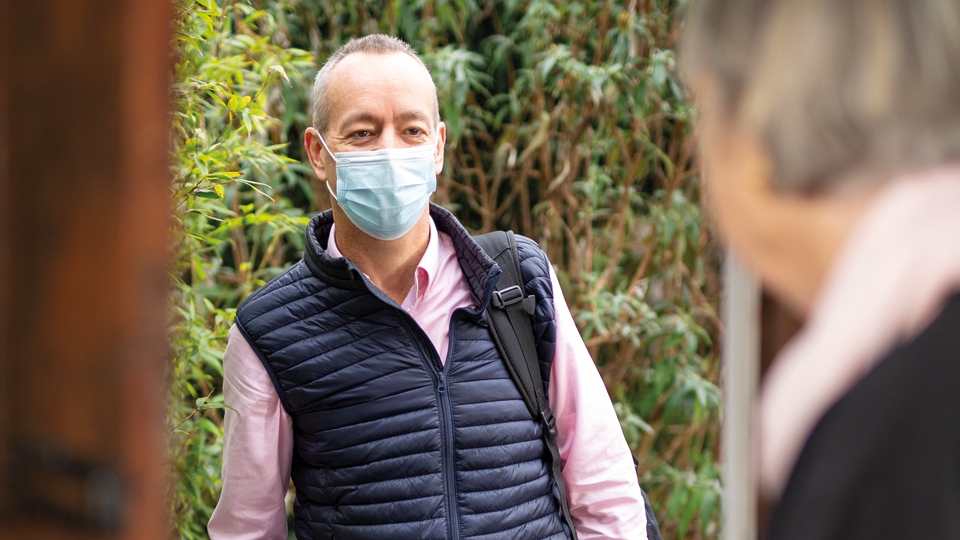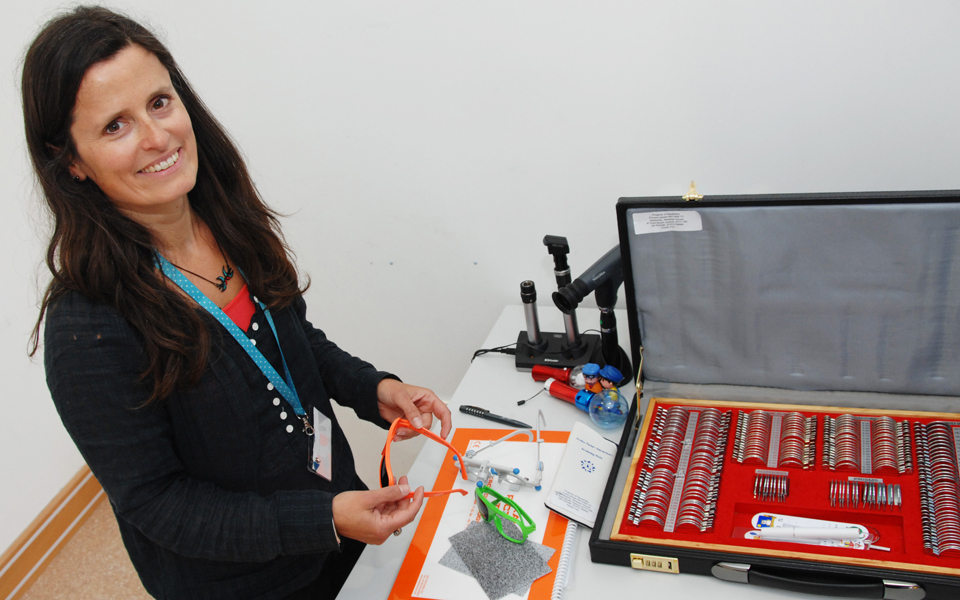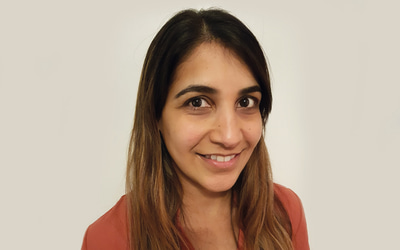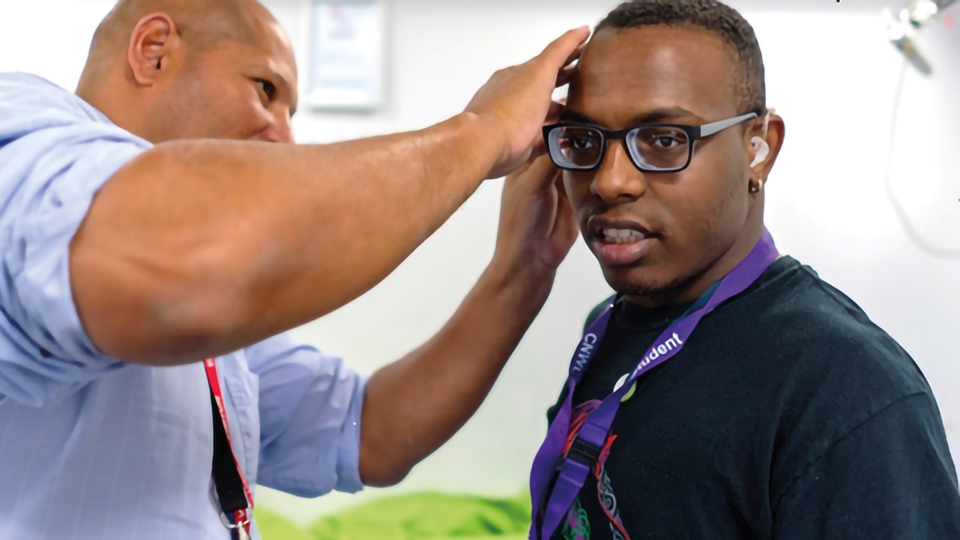- OT
- Professional support
- Health services
- Home comforts
The cover story
Home comforts
The pandemic has put a spotlight on the value of domiciliary optometry. OT explores the life-changing impact of bringing care to a patient’s doorstep

21 February 2022
As strict measures to stem the spread of COVID-19 brought routine sight tests in the UK to a halt, Paul Chapman-Hatchett continued to serve patients by cycling around 300 miles each week to replace and repair spectacles.
For patients in their own homes, who make up the bulk of the Surrey optometrist’s caseload, having a familiar face appear on their doorstep offered a sense of normality in an otherwise challenging and often lonely time.
“I think everyone was very scared. If you broke your glasses, that was pretty debilitating for a lot of people. To be able to go out there and say ‘We can come and sort you out on your doorstep with some new frames or repair your glasses’ – that was immensely satisfying,” Chapman-Hatchett emphasised.
While the pandemic brought challenges – such as changing regulations and restrictions on care – it also heightened public awareness of services that can be delivered to a patient’s door.
Patients previously unfamiliar with domiciliary care realised that as well as having groceries delivered to their door, they could also get their eyes checked from the comfort of their own home.
OutsideClinic domiciliary optometrist, Steve Clark, shared with OT that the public profile of domiciliary is one of the key challenges for the sector.
“The biggest feedback I get is ‘Oh thank goodness I found you – I never knew you existed’,” he said.
The latest annual statistics from NHS Digital show that 462,250 domiciliary sight tests were performed between 2019 and 2020 in England – accounting for 3.5% of all NHS-funded sight tests.
The number of domiciliary sight tests performed in England has close to doubled since 2002, when 254,795 domiciliary tests were performed.
While the number of domiciliary sight tests performed is substantial, it is significantly smaller than the number of home visits performed by GPs each year in England, at around three million.
“If you look at the figures of how many people are unable to leave their own homes without support and then you look at the number of GOS sight tests done in a person’s home – the two are not the same. There is a huge demand out there,” Clark observed.
Factors such as an ageing population and people living in their own homes for longer are likely to see the sector continue to expand over the coming decades.
The Office for National Statistics estimates that one in four UK residents will be aged 65 or older by 2066.
Chapman-Hatchett predicts that domiciliary optometry will grow to serve the eye care needs of this population.
“We are the future of optometry, in my opinion,” he said.
Domiciliary during COVID-19

“They would ask ‘Who are you?’,” he shared.
“They got used to the idea that this optometrist would turn up on his bike and do whatever needed to be done,” Chapman-Hatchett added.
Chapman-Hatchett’s approach of going the extra mile for patients – in this case literally – has been integral to his business since Care Opticians was established 25 years ago.
The domiciliary provider now has 11 branches across the UK and employs 15 optometrists.
“The Grandmother Test is the cornerstone of our business,” he shared.
“It works around the principle that you treat the patient like you would want one of your family members to be cared for,” Chapman-Hatchett said.
The first patient Chapman-Hatchett saw after a six-week hiatus from sight testing was a man with terminal cancer whose family lived abroad. The patient could no longer see his laptop screen during video calls.
After persuading the patient’s care home to allow him to perform a sight test, Chapman-Hatchett dispensed the patient with a new pair of glasses that brought his family members’ faces into focus.
“He died about three months later but without that sight test he would have lost the opportunity to see his family… he will be with me forever,” Chapman-Hatchett shared.
As a domiciliary optometrist, Chapman-Hatchett gains valuable insight into the daily visual needs of his patients that is not necessarily available to optometrists on the High Street.
“The first thing I say to almost all of my clients is, ‘Sit in the chair you would normally sit in. If we set everything up for that chair, you’re happy and I’m happy,” he said.
The solutions that Chapman-Hatchett comes up with are not always refractive in nature. For example, if a patient is struggling to read subtitles on their television, he may recommend moving the television closer.
Or if they are experiencing difficulties reading, he will look at how the lighting is set up in the room.
“The most important thing is to listen,” Chapman-Hatchett observed.
“It is about understanding what the aspirations of the patient are and delivering on those aspirations,” he said.
Since Chapman-Hatchett first started working as a domiciliary optometrist, the technology has improved and the kit that he carries has become lighter, while the variety of the role has kept him hooked.
“For me personally, and for a lot of people who do domiciliary, the idea of being stuck in a back room testing eyes all day was the thing that put me off working in a practice. Being out in the car and driving around, seeing the world, is what I like. Every patient and every environment is different,” Chapman-Hatchett said.
It is a service that is by its nature personal – and one that patients appreciate, with Chapman-Hatchett receiving Christmas cards and the occasional bottle of homemade wine.
“A lot of them talk about their families, kids and marriages. When my girls were young, they would ask about my children,” he shared.
“We become a part of their life,” Chapman-Hatchett added.
Returning to work
Domiciliary optometrists returning to work in June 2020 faced a very different professional landscape to the one they had left in March. For Clark, it was his longest break from sight testing in his 31-year career.
There were enhanced infection, prevention and control (IPC) procedures – but for many optometrists there was also a degree of trepidation in returning to treat patients in the absence of effective vaccines or rapid testing for COVID-19.
“Frankly, I was initially scared about going back to work,” Clark said.
Close to two years after the initial outbreak of COVID-19, a vaccinated population, embedded IPC processes and widely available lateral flow tests have provided reassurance to the domiciliary workforce.
“We are a lot more confident that we are controlling any risk,” Clark shared.
He added that the break from sight testing gave him a newfound appreciation for his role.
“On a personal front, I realised that I really liked working as an optometrist, meeting people, delivering the best service I can and improving people’s lives,” Clark said.
“At the end of the working week, on a Friday night, that is one of the things that motivates me. I think I have made a difference,” he emphasised.
Reflecting on memorable moments over his 17 years of delivering home visits, Clark recalls arriving at a farmhouse in the Yorkshire Dales which was so remote that it bewildered his GPS.
After being welcomed into a room with a roaring fire and flagstones on the floor, it became clear over the course of the visit that the retired farmer had Charles Bonnet syndrome.When I talked him through the fact that it was normal for his eyes to see small animals or people walking across the floor, there was massive relief for him and quite a lot of surprise from his son that he hadn’t spoken about it
The patient had not spoken to anyone within his family about what he was seeing as he was afraid that he might lose his independence.
“When I talked him through the fact that it was normal for his eyes to see small animals or people walking across the floor, there was massive relief for him and quite a lot of surprise from his son that he hadn’t spoken about it,” Clark said.
An aspect of the job that Clark enjoys is that his consulting room is always changing.
“When I walk into a room, I’m thinking ‘They haven’t got any curtains, how am I going to deal with that?’ Or if someone is completely bed-bound – ‘Where am I going to put my chart so they can see it?’,” he said.
“I like the fact that you have to be on your toes and you have to be thinking about how to handle a situation in the best interests of the person who you are seeing,” Clark shared.
Turning to misconceptions about domiciliary optometry, Clark shared that in contrast to the perception that a lot of domiciliary work is in care homes, he mostly conducts home visits for individuals.
He also noted that there is potential for a portfolio career within domiciliary optometry – optometrists can continue to work on the High Street alongside home visits.
“There is a misconception that we don’t have the latest technology,” Clark added.
“I have a tablet sitting in front of me. We have been using electronic records for 15 years. I have a portable slit lamp, an iCare tonometer and I take fundus photographs. I have almost everything that a High Street optometrist has,” he emphasised.
Although domiciliary optometrists do not currently have access to a portable optical coherence tomography (OCT) device, research is underway at several universities to develop this technology.
For example, in 2019, Ge Song and colleagues at Duke University in the US tested the eyes of 60 patients using their portable, standalone, low-cost OCT system.
Describing the results in Translational Vision Science & Technology, the scientists highlighted that the images were of “adequate resolution and allowed for clinical diagnostics.”
“It offers comparable performance as a retinal screening tool at a fraction of the cost of current commercial systems,” the authors shared.
The cost of the system was $5037 USD (£3722) while its total weight was 2.3 kilograms. Requiring only 12 watts of power to function, the device could be powered solely by batteries.
Bringing domiciliary eye care to special schools
The average patient seen by Clark and Chapman-Hatchett is in their 80s – but domiciliary optometry is also making a life-changing difference for much younger individuals.
In June, NHS England commenced the roll out of a comprehensive eye care service for children in special schools – with the aim of providing 128,000 children at 1000 schools eye care by April 2023.
Through the service, an eye care duo of an optometrist and dispensing optician test the vision of pupils at special schools.

“We support them to get used to that refractive correction. The dispensing opticians are absolutely vital to the success of the model,” head of eye care and vision at SeeAbility, Lisa Donaldson, shared with OT.
The roots of the service began in 2013, when charitable funding enabled SeeAbility to start testing the vision of children within two special schools.
Over time the project grew, culminating in 2019 with the publication of data from eye examinations of 949 special school pupils.
The largest global study of its kind revealed stark disparities in the provision of eye care to children with special needs in England.
While half of children within the group had an eye health need, 44% had never had their sight tested.
Only one in ten children had accessed a community optometry practice.I feel very privileged to be working with these children
“Where children were receiving care, it was typically within the hospital. We were finding that once they were leaving hospital care they were not getting followed up,” Donaldson explained.
Now that the Special School Eye Care Service is being rolled out, each week teams are entering new schools and finding children who are functionally visually impaired.
“You think of this as something that happens in countries where they don’t have such good health care services – where people are not getting refractive correction or cataract surgery. It is actually happening in our UK special schools,” Donaldson shared.
There were false-starts and challenges in the eight years it took to get the service commissioned.
“It has seemed like a very long journey. You have convinced one person and then they leave. You have to start again,” she shared.
This NHS funded program is currently in a proof-of-concept phase with plans to embed it in permanent provision from April 2023.
The success of the programme is supported by the tenacity of many individuals, including SeeAbility’s policy manager Donna O’Brien and NHS England programme manager, Richard Everitt.
“We are all quite stubborn and until there are services for all 128,000 children, we will be on the case,” Donaldson emphasised.
The difference a frame makes
Lisa Donaldson: “When we are going into new schools, every week we are finding a child who is functionally visually impaired. It could be a child who is deemed unable to access eye gaze software for cognitive reasons when a pair of glasses would open up that form of communication for them. Or you might have a child where it is assumed that all their behaviours are down to their autism – the fact that they don’t engage with tasks and are withdrawn – then you discover that they are +6”
Malvi Patel: “There was a little girl who never really engaged in the classroom. After she got her new pair of glasses, they went to the National Gallery in London for a school trip. This little girl’s jaw dropped and she was just looking around in awe. Stories like that make you think ‘Oh my goodness, what we are doing is so, so worthwhile’”
A tailored test
Optometrist, Malvi Patel, has been working for SeeAbility since April 2021. She shared with OT that the role has given her a newfound passion for optometry.
“Now I look forward to going to work. I feel very privileged to be working with these children,” she shared.

“One of the beauties of working in the school is that it is a familiar environment for the children,” Patel shared.
If a child is resistant to a certain test, then Patel and Reuben can try another approach or reschedule the appointment for a different time.
“When I initially started I was desperate to try and get everything for every child,” Patel shared.
“It is knowing to let go, and think ‘Fine, let’s try something else.’ You can always try it the following week,” she observed.
A range of specialist testing equipment is on hand, such as tracking toys, illuminated balls, Bradford beads and the vision testing app, Peekaboo.
Patel highlighted that the appointments are led by the child.
“You start with games – you might do motility with a toy, or near point of convergence test where you say ‘The bumblebees are going to come and kiss you on your nose’,” Patel shared.
Optometrists and dispensing opticians recruited through the service receive three days of paid training, providing insight on how to test the vision of children with special needs.
Patel always addresses the child when performing a sight test, even if they are non-verbal, and added that patience is key.
“We have the eight second rule. For motility, for example, we show them the toy but then we wait eight seconds before we start moving it. For some children, it takes longer to process information.”
The magic of sight

“The main one is – don’t be sure of your outcomes. Expect the unexpected. We know that something should go one way and then we are dumbfounded,” he shared.
In contrast to High Street dispensing constrained by the value of a GOS voucher, spectacles dispensed through the service are funded directly by the NHS.
“We get to choose the pair of glasses, the frames and the lenses, that the child needs without being encumbered by the price,” Reuben explained.
Durable, high-quality frames are featured within the service’s range, with frames by Tomato, Centrostyle, Miraflex, Erin’s World and Swissflex.
The first priority is choosing a frame that is safe, while comfort, fit and the child’s preferences are also key. Reuben shared that he rarely has bad days in his job.
“People say ‘Isn’t it depressing working with hundreds of children who have difficulties?’ My answer to that is ‘No, it is depressing trying to sell someone a pair of varifocals for £600 when they might not necessarily need them.’ Making glasses for these lovely children is just fun,” he said.Some of the non-verbal kids will see me and then just tap their glasses. They know I am the glasses man
The dispensing optician learned a series of magic tricks through online videos as a way of engaging his young patients.
Alongside a handkerchief and fake thumb, Reuben carries a repair kit and small notebook so he can fix spectacles on the go.
“When you walk around the school you are constantly seeing all the children’s glasses that you have dispensed. You can do a quick spec check in the corridor, maybe, just saying, ‘How are you getting on with your glasses?’ or ‘Can I just tighten those up behind your ear?’,” Reuben said.
Asked whether the children see him as a magician or a dispensing optician, Reuben shared: “Some of the non-verbal kids will see me and then just tap their glasses. They know I am the glasses man.”
Optometrists and dispensing opticians interested in becoming involved in the Special Schools Eye Care Service can contact [email protected] for more information. A short video explaining the service is available online.
Advertisement


Comments (0)
You must be logged in to join the discussion. Log in